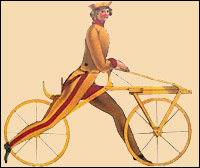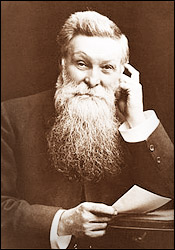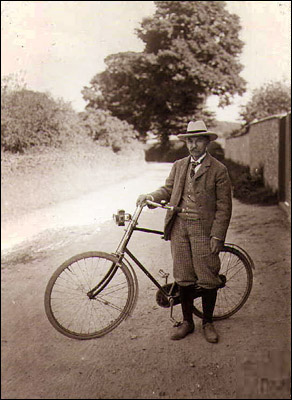2009
The Dawn of the Velocipede

It started with the "Draisine"
Such a machine could double or even triple the normal walking speed of an enthusiastic user, though range and comfort must have been severely limited, compared to what a standard bicycle can now achieve.
A chaotic variety of bicycle-like objects followed, as artisans devised two-, three-, and four wheeled contraptions driven by treadles (such as those common for powering sewing machines) or rod arrangements similar to those connecting the pistons of a steam locomotive to its wheels, but none had much success. It was left to the French (who later developed the city bike to what many consider its apotheosis) to build the first true pedal bicycle, in 1863, a scant 150 years ago. Pierre Lallement, who eventually had to defend his claim to the invention in court, added pedals to the front axle of a draisine, and refined the design with a leaf spring holding the seat, for comfort, and thus was born--not the modern bicycle, not yet; but the ancestor of the high-wheeler, or "ordinary," or "penny farthing."

Tall in the Saddle
The high-wheeler was not only be fast, it was dangerous, so it caught the attention of sporting types. Bicycling became the "extreme sport" of the era, with the ever-present risk of "taking a header" over the gigantic front wheel adding spice to every ride--for the high and forward center of gravity made endos an all-too-common occurrence.
The "Safety Bicycle"
But a machine that by its nature limits its appeal to musclebound daredevils does not a practical transport modality make, and the bicycle industry knew it. A solution was just around the corner, and it involved chains and gears, and a magical rubber tube....

Early Safety Bicycle (pre-1900)
This made it possible to abandon the high-wheeler concept, and build a bike with small wheels that could speed along as fast as, or faster than, than high-wheeler, with almost no danger of going over the bars. Smaller wheels, low center of gravity, better handling, more varied seating positions, the possibility of varying the overall gear ratio on a single machine, and the ability to ride long distances with relatively little effort--all this is dependent on the chain.
Yes, shaft-driven bicycles have been built, but the shaft drive saps energy and makes it practically impossible to customize gear ratios; belt-driven bikes have been built, but they are simply variations of the theme of the drive chain, the fundamental technology that makes the bicycle practical.
Chain drives had existed in factories for many years prior to their introduction to the bicycle, but early chains were not suitable for the rugged use to which riders put them. But in 1880, Hans Renold of the eponymous Renold Chain Company invented the bush roller chain, ancestor of all modern drive chains. In 1885 he patented the block chain, a tougher variation, and then did something that would be unheard of in our modern world outside of the open-source software realm: to quote the company history (Renold is still in existence today), Hans "decided to openly give his idea to the cycle trade for all to freely manufacture. Undoubtedly he gained many friends by this charitable action."
Every modern-day cyclist should maintain a shrine to Hans Renold, for without him, the safety bicycle might have remained an expensive niche product, and the bicycle not have become what it is even today, the most-used means of transportation on Earth.
Calling Dr. Dunlop
The paradigm was yet incomplete, however, as tires left much to be desired in those early days.

Dr. Dunlop
Dr. Dunlop set to work and made what was in effect a crude sew-up tire. He pressurized it with a pump he had for filling soccer balls, set the kid back on the tricycle, and realized he had a hit on his hands.
Now, the pneumatic tire had in fact been invented once before, in 1845, by a fellow named Robert William Thompson--but Thompson (who died in 1873) applied his tires only to industrial machinery. In 1888, Dunlop patented his own variation of the pneumatic tire and marketed it to the ever-growing community of bicyclists, incidentally founding a company that is still making tires today--and making possible the first great bike boom, that of the late 19th century.
As bicycle historian David Herlihy notes, "The chain-driven 'safety' bicycle with inflatable tires was, in essence, the culmination of an age-old dream: a valid human-powered vehicle that was both pleasurable and practical."
An End and a Beginning
In essence, the bicycle was now complete. Subsequent evolution has been devoted to refining the expressions of an almost perfect paradigm. Indeed, by 1906, you could read in a brochure by Barrett's Ironmongery Stores, Cycle Department: "The cycle is, today, a universal vehicle, transporting its votaries from point to point swiftly, surely and inexpensively, whilst there is in addition that to be gained which other methods of transportation, save walking, do not afford, viz., a health ensuring, invigorating exercise." A statement that is as true today as it was over a hundred years ago, while a bicycle of that era is instantly recognizable to a rider of today, as any of today's bikes would be to a wheelman or -woman of 1900, as nothing other than a bicycle.
The bicycle's effect was far-reaching and profound, for it brought freedom and opportunity with it. Now, people of ordinary means could travel far and fast, farther and faster, indeed, than the rich in their carriages. Whether it was across town to a better job, or out of town into the countryside for a picnic, it was a taste of liberation that made cyclists giddy with enthusiasm, and more.

Thomas Hardy with his "byke"
Hardy lived in a small town in rural England, but in those days city dwellers often lived in what were small towns within the city, rarely going far from their own neighborhoods--and when they did, in the age of low-wage industrial capitalism, it was usually on foot. But with the purchase of a bicycle, even a used or very modest new one, city dwellers expanded their range at least fourfold, and what used to be an expedition requiring half a day (or the purchase of a pair of tram tickets) became a quick jaunt that cost nothing. By 1900, a bicycle could be had for as little as fifty dollars, when a workingman's wage might be around $500.00; by comparison, today a very modest car will cost at least twenty thousand dollars new, and most are much more. The average income for a US resident in 2005 was about $55,000.00, so a basic transportation automobile today costs one-third of an average Joe's salary, as opposed to the one-tenth a bicycle would have cost him at the very end of the 19th century. (Even if you use the median income figure of $32,000.00, the bicycle is an impressive bargain.)
Ironically, bicycles today, despite their extremely high quality, are proportionately cheaper than they were in 1900, as for one-tenth of the average salary today, or $5500.00, one could buy nearly the most extravagant custom-made bicycle available!
Bikes and the City
The bicycle even helped to shape cities, primarily through the activities of cycling clubs and the Good Roads movement, which was founded in 1880 by the League of American Wheelmen, originally a cyclists' lobbying group that is still active today. US roads at that time were generally dirt or mud tracks and, even in cities, poorly maintained. American cyclists pointed out the superiority of European roads, for both cycling and general travel, and over the three or four decades of the movement's formal existence, succeeded in establishing the principle that good roads were part and parcel of a town's, city's, or state's public responsibility.
Ironically, it was thus cyclists who literally paved the way for the automobile that arrived on the scene around 1900, and which has usurped so much of public space in our cities since, to the detriment not only of cycling, but all public life.
While the automobile was overwhelming American roads, towns, and cities, in Europe the car always coexisted with the bicycle. To this day, while the proportion of travel miles accomplished by bicycles varies wildly in Europe, the continent as a whole embraces cycling as a normal mode of travel for citizens of all classes--as does Japan. In Copenhagen, as of 2006, 36% of travel miles are accomplished on bicycles (and much of the rest on public transport), with similar proportions in Holland, and lesser but still significant use in Germany, Norway, and Sweden. In 2008, Virgin Air published a list of the eleven most bicycle-friendly cities in the developed world, listing two in frigid Norway! The cities are:
- Amsterdam
- Portland, Oregon
- Copenhagen
- Boulder, Colorado
- Davis, California
- Sandnes, Norway
- Trondheim, Norway
- San Francisco
- Berlin
- Barcelona, Spain
- Basel, Switzerland

Parking for a Shopping Mall in Osaka, Japan
Despite the inclusion of US cities on the list, the Europeans still surpass Americans in their day-to-day acceptance of cycling as transportation: where in Portland at the time of this writing a mere 6% of daily travel occurs on bicycles, in Amsterdam it's over 40%; in Copenhagen, as we mentioned before, 36%; in Trondheim, 18%; and in Berlin (the European laggard) 12%--still double that of America's star city of Portland.
China and India, of course, despite encroachments by car culture, still put more bikes on the road than the rest of the world combined, no doubt; while in staid Japan, the bicycle is a feature of the landscape as ubiquitous as the sky, and everyone from mothers out shopping with the kids to bank managers in dull gray suits can be found pedaling to and from home and subway stop, office, or store. Bicycles are everywhere, and there are even pay parking lots for bikes.
In short, the bicycle and the city are made for each other, and the bicycle has shaped, and is still shaping, the modern city, as much as the need of city dwellers to get about has driven the development of the bicycle for most of its history.
Text and Osaka photo by Richard Risemberg

